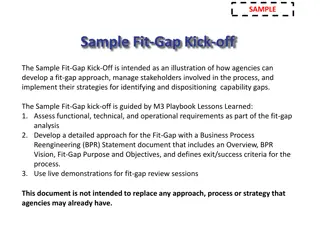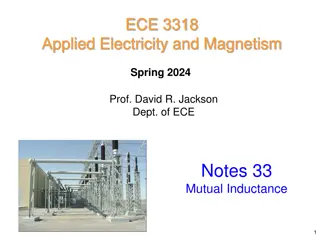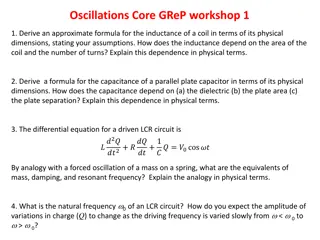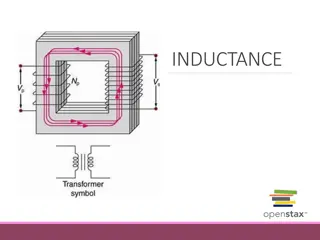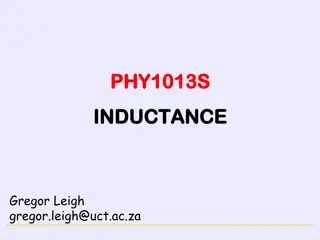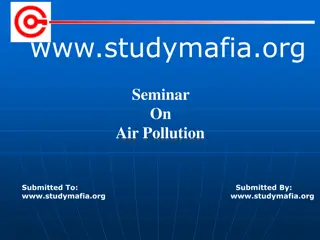Understanding the Effects of Air Gap Tolerance on Inductance Tolerance
This technical note delves into the impact of air gap tolerance on inductance tolerance in transformer manufacturing. It explains how controlling the core's air gap dimension is crucial for maintaining desired inductance levels within manufacturing constraints. The text discusses the small scale of air gaps in comparison to magnetic path lengths, the process of gapping cores, and the relationship between air gap and permeability. Furthermore, it explores how introducing an air gap in the core can enhance the effective permeability of materials with broad tolerance ranges. The document also touches upon the influence of manufacturing tolerances on inductance tolerance, specifically focusing on typical ferrite gapping machine precision.
Download Presentation

Please find below an Image/Link to download the presentation.
The content on the website is provided AS IS for your information and personal use only. It may not be sold, licensed, or shared on other websites without obtaining consent from the author. Download presentation by click this link. If you encounter any issues during the download, it is possible that the publisher has removed the file from their server.
E N D
Presentation Transcript
- Minntronix Technical Note - Effects of Air Gap Tolerance on Inductance Tolerance Dave LeVasseur VP of Research & Development Minntronix, Inc. 4-Mar-2016
Inductance Tolerance As transformer manufacturers we are sometimes asked to provide parts with inductance tolerances that are too narrow for reasonable manufacturing efficiency and production yield. The core s air gap is the key to providing controlled inductance but its dimension is subject to the limits of mechanical tolerance control. This App Note describes how magnetic cores are typically gapped and the effects of gap tolerance on inductance tolerance.
Inductance Tolerance The air gap is typically quite small when compared to the core s entire magnetic path length. Gaps are typically 0.001 to 0.1 (0.00254 to 0.25cm) compared to typical path lengths of 20-100cm for parts up to the size of a human fist. Magnetic path length LM air gap length Lg Air gaps can be ground into the center leg using a wet grinding technique. Large gaps may require several passes. Small gaps can be done in one pass but due to manufacturing tolerance may vary 0.00025 (6.4um) from part to part. Video still image from YouTube: https://youtu.be/TbbNw8JO7m0 *Gapped core image courtesy of Encyclopedia Magnetica: www.encyclopedia-magnetica.com
Effects of Air Gap on Permeability Rc (t) Air gap Lg Rg Path length LM Physical Geometry Magnetic Circuit
Effects of Air Gap on Permeability Air gap Lg L 1 M = = Magnetic path length LM e e M L L L 1 g g M + + Core with magnetic path length LM * L M g M M Core with magnetic path length LM and air gap Lg * For this example we ll assume the permeability of the air gap to be 1
Effects of Air Gap on Permeability L 1 M Materials having high permeability also have a broad tolerance on their permeability. Materials with permeability greater than 10,000 may specified as minimum-only. = = e L L L 1 g g M + + * L M g M M * For this example we ll assume the permeability of the air gap to be 1 To make the effective permeability e have a tighter tolerance we must introduce an air gap in the core. Rearranging the formula to solve for the ratio of Lg to LM yields: L 1 1 g = L M e M
How manufacturing tolerances affect inductance tolerance Given that once it is set up a typical ferrite gapping machine will stay within 0.2 thousandth of an inch (about 5um). For sake of example assume a typical power ferrite of size EE20 has a material permeability of 2000 and that we need to determine if we can control the inductance of a 15T winding to 100uH 5%. The EE20 core has a magnetic path length LM of 4.28cm and cross-sectional area of 0.312cm2. Rearranging this: to solve: for e: ? ?? 108 0.4 ?2 ?? ? =0.4 ?2 ?? ? ?? 108 ?= 100 4.28 108 0.4 152 0.312=485.2 ?= Plugging in the values:
How manufacturing tolerances affect inductance tolerance Although the actual gap calculation is an iterative process we can start to determine the gap using the effective permeability obtained with the starting values: Rearranging this to solve for Lg: L 1 1 ??= ??[1 1 g = ] L ? ? M e M Plugging in the values: 1 1 ??= 4.28 485.2 = 0.0067?? = 67?? = 0.0026" 2000 (For sake of simplicity we are ignoring effects of flux fringing which typically impacts results when Lg is > 1% of the path length, but core shape and aspect ratio also play roles in this: http://www.encyclopedia-magnetica.com/doku.php/air_gap)
How manufacturing tolerances affect inductance tolerance If our gapping tolerance is 0.0002 (0.0508cm) the range of air gap becomes 0.0026 0.0002 = 0.0024 to 0.0028 (0.0061 to 0.0071cm = 0.061 to 0.071mm) Putting this range back into the equation for effective permeability results in: 1 1 1 1 = = = = = = 463 2 . 519 4 . e e Low High 0071 . 0 28 . 4 1 L 0061 . 0 28 . 4 1 L 1 1 + + g g + + 2000 2000 L L M M M M ? =0.4 ?2 ?? ? ?? 108 Running these through this: ????=0.4 152 0.312 463.2 4.28 108 ????=0.4 152 0.312 519.4 4.28 108 = 95.5 ? = 107.1 ?
How manufacturing tolerances affect inductance tolerance A range of 95.5 to 107.1 H results in a spec of 101.3 H 6%. So not only are we unable to meet the desired 5% tolerance the nominal value is offset by +1.3% due to the greater change in permeability as the gap dimension falls on the low (smaller) side. Note that the gap grinding tolerance of 0.00025 (6.35um) is used for example only. The actual variation is a function of the size of the core being gapped, the flatness and cleanliness of the grinding table and wheel in addition to variation in the permeability of one core to the next. One possible solution to this problem is to add turns until the gap dimension becomes large enough that the gap variation plays less of a role and allows the inductance spec to be met. With this example an increase from 15T to 17T will work. See this App Note s companion spreadsheet: Effects of Permeability and Air Gap Tolerance on Inductance.xlsx. - end -









